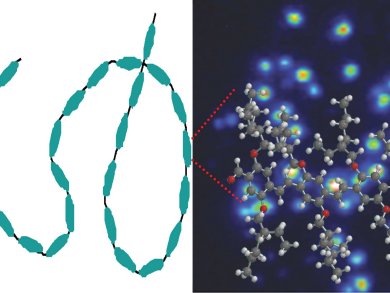Polymer objects that appear to be one-dimensional may adopt complex 3D structures, which dramatically influences their fundamental electronic and optical properties, says John Lupton, University of Regensburg, Germany, and the University of Utah, USA.
Combined single-molecule and ensemble time-resolved studies suggest that the π-bond in large macromolecules, such as conjugated polymers, is remarkably persistent in space. “Even individual chromophores can be bent and twisted, so that caution is warranted when interpreting a wide range of polarization-based spectroscopies”, the researcher reports.
Conjugated polymers, which are characterized by alternating single and double electron bonds between carbon atoms to enable electrical conduction, feature prominently in the field of plastic electronics and have interesting applications in light-emitting and photovoltaic devices.
Image: © Wiley-VCH
- Chromophores in Conjugated Polymers — All Straight?,
J. M. Lupton,
ChemPhysChem, 2011, 12.
DOI: 10.1002/cphc.201100770




